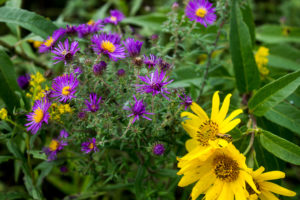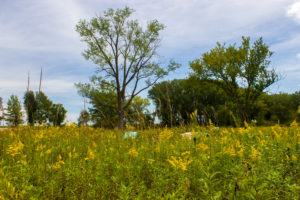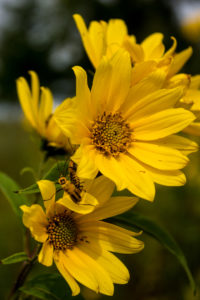Lessons from the Remnant: Resilience and Care
In these days of so much human restriction, the natural world can provide us with great benefit—opportunities to just get outside the house, as well as opportunities to learn more about and connect more deeply with the land and all that lives on it. We are fortunate that Bur Oak Land Trust has beautiful and inspiring properties close by for us to enjoy (as long as we practice social distancing and, of course, the usual stewardship). The spring awakening gives us special joy after the dormancy of winter and amidst the constraints of self-isolation. Aside from learning more about the flora and fauna of our woodlands, waterways, and prairies, the Trust’s natural areas can teach us important lessons about our relationships with land and about life in general in the time of coronavirus.
 Last fall, I ventured for the first time to Strub Prairie, a diverse one-acre native prairie remnant that boasts over 100 native species. In September, the prairie was filled with the yellow of silphium and goldenrod, punctuated by the purple of aster. But even more impressive than autumn’s wildflower display was the sense of history and stewardship. As I say in the book I co-authored with Cindy Crosby, Tallgrass Conversations: In Search of the Prairie Spirit, “The most authentic prairie experience possible is not in restorations, which by definition have lost their direct lineage to a continuous ecosystem, but in remnants, where native plants are the discarded original elders of the tallgrass. . . . On the prairie, the remnant is original renewal, not inventive replication. It is the remains of the real in a world of artifice.”
Last fall, I ventured for the first time to Strub Prairie, a diverse one-acre native prairie remnant that boasts over 100 native species. In September, the prairie was filled with the yellow of silphium and goldenrod, punctuated by the purple of aster. But even more impressive than autumn’s wildflower display was the sense of history and stewardship. As I say in the book I co-authored with Cindy Crosby, Tallgrass Conversations: In Search of the Prairie Spirit, “The most authentic prairie experience possible is not in restorations, which by definition have lost their direct lineage to a continuous ecosystem, but in remnants, where native plants are the discarded original elders of the tallgrass. . . . On the prairie, the remnant is original renewal, not inventive replication. It is the remains of the real in a world of artifice.”
 The continuity of a prairie remnant grounds us—literally—in the land as it was centuries ago. Even more importantly, we understand the land’s persistence and renewal thanks to the healthy diversity and interdependence of an intact, functional ecosystem. One of the major lessons, then, of Strub Prairie is resilience—that the wild world, even after nature’s own trials and tribulations, renews itself. That’s a good lesson in these days of pandemic—that while we will experience tragic loss, and while our human world will be significantly altered even when the virus has passed, we can be resilient and renew ourselves, especially if we practice interdependence and value the diversity that lie at the root of a good society.
The continuity of a prairie remnant grounds us—literally—in the land as it was centuries ago. Even more importantly, we understand the land’s persistence and renewal thanks to the healthy diversity and interdependence of an intact, functional ecosystem. One of the major lessons, then, of Strub Prairie is resilience—that the wild world, even after nature’s own trials and tribulations, renews itself. That’s a good lesson in these days of pandemic—that while we will experience tragic loss, and while our human world will be significantly altered even when the virus has passed, we can be resilient and renew ourselves, especially if we practice interdependence and value the diversity that lie at the root of a good society.
 The “world of artifice” I mentioned—our industrial agriculture, our housing and commercial developments, our roads, our pollution, and more—always threatens the native ecosystems that remain. But as a remnant, Strub Prairie also teaches us an important companion lesson—that in the twenty-first century, resilience persists through care. As a land trust, Bur Oak Land Trust has taken on the responsibility of care for this small remnant, and this bit of land’s self-regeneration, ironically, requires human intervention to keep it safe from the ravages of the world humans have created. That is at the heart of the stewardship mission of the Trust, not just for Strub Prairie but for all its properties—resilience through care.
The “world of artifice” I mentioned—our industrial agriculture, our housing and commercial developments, our roads, our pollution, and more—always threatens the native ecosystems that remain. But as a remnant, Strub Prairie also teaches us an important companion lesson—that in the twenty-first century, resilience persists through care. As a land trust, Bur Oak Land Trust has taken on the responsibility of care for this small remnant, and this bit of land’s self-regeneration, ironically, requires human intervention to keep it safe from the ravages of the world humans have created. That is at the heart of the stewardship mission of the Trust, not just for Strub Prairie but for all its properties—resilience through care.
Likewise, care of each other has rarely been more important than it is in this viral moment in human history. Our compassion and cooperation, as well as our science and ingenuity, are essential for us as a species and as a people to remain resilient in a world full of disruption and threat, most of which we have brought on ourselves. Those are lessons we must keep with us amidst and after the pandemic, and we can see them at work as we enjoy the beauty and inspiration of the grasses, forbs, insects, birds, animals, and soils of Strub Prairie.
Tags: resilience, Strub Prairie, Thomas Dean

